Modeling of Turbidity Variation in Two Reservoirs Connected by a Water Transfer Tunnel in South Korea
Abstract
:1. Introduction
2. Materials and Methods
2.1. Study Area
2.2. Model Selection and Description
2.3. Model Input Data Adjustment
2.4. Turbidity Estimation
2.5. Model Application
2.5.1. Model Validation/Verification
2.5.2. Simulation Scenarios
3. Results and Discussion
3.1. The Turbidity Distribution Based on Water Transfer Tunnel
3.2. Released Water Turbidity Current Effect Due to a Tunnel Connection
3.3. The Effects of Selective Withdrawal
4. Conclusions
- (1)
- When the water transfer tunnel is constructed, the released water turbidity at Imha reservoir decreased by 22%, compared with the released water turbidity in 2006. However, the released water turbidities at Andong reservoir are similar to those in 2006 whether the water transfer tunnel was operated or not, although Park and Chung [17] were concerned about the large turbidity transport problem at Andong reservoir due to the water transfer tunnel.
- (2)
- The three withdrawal depths (EL. 141.0 m, EL. 146.5 m, and EL. 152.0 m) are considered and applied to the two water transfer periods (2002 and 2006) from the Imha to Andong reservoirs. The turbidity profiles of the Imha reservoir decreased significantly, but the turbidity profiles of the Andong reservoir only increased slightly because the storage volume of the Andong reservoir is more than twice that of the Imha reservoir. The withdrawal water turbidity in EL 152.0 m shows the lowest turbidity among the three scenarios because turbidity currents mostly occur at about EL. 130–145 m (20–30 m below the water surface) in the Imha reservoir and water density depending on depth in summer season are different due to stratification of reservoirs.
- (3)
- Based on K-water [32], median particle size ds ≅ 20 μm and the ratio of SS (mg/L)/NTU is 0.7 in the Imha reservoir. An and Julien [16] estimated the particle size of turbid density currents at the Imha reservoir to be between 10 and 40 μm, because the settling is not significantly below 10 μm of particle size, and settling occurs predominantly over 40 μm. Also, concentration of turbidity density current, regarded as transitional regime, is expected to be between 2000 and 3000 mg/L at Imha reservoir because the concentration of interflow is represented when below 2000 mg/L and the concentration of underflow is shown when over 3000 mg/L.
Supplementary Materials
Acknowledgments
Author Contributions
Conflicts of Interest
References
- Gökbulak, F.; Serengil, Y.; Özhan, S.; Özyuvacı, N.; Balcı, A.N. Effect of timber harvest on physical water quality characteristics. Water Resour. Manag. 2008, 22, 635–649. [Google Scholar] [CrossRef]
- Iglesias, C.; Martínez Torres, J.; García Nieto, P.J.; Alonso Fernández, J.R.; Díaz Muñiz, C.; Piñeiro, J.I.; Taboada, J. Turbidity prediction in a river basin by using artificial neural networks: A case study in Northern Spain. Water Resour. Manag. 2014, 28, 319–331. [Google Scholar] [CrossRef]
- Michaud, J.P. A Citizen’s Guide to Understanding and Monitoring Lakes and Streams; Publ. #94-149; Washington State Department of Ecology, Publications Office: Olympia, WA, USA, 1991.
- Davies-Colley, R.J.; Smith, D.G. Turbidity, suspended sediment, and water clarity: a review. J. Am. Water Resour. Assoc. 2001, 37, 1085–1101. [Google Scholar] [CrossRef]
- Lawler, D.M.; Petts, G.E.; Foster, I.D.L.; Harper, S. Turbidity dynamics during spring storm events in an urban headwater river system: the upper Tame, West Midlands, UK. Sci. Total Environ. 2006, 360, 109–126. [Google Scholar] [CrossRef] [PubMed]
- Moore, M.L. NALMS Management Guide for Lakes and Reservoirs. North American Lake Management Society, 1989. Available online: http://www.nalms.org/ (accessed on 1 December 2016).
- Kim, Y.; Kim, B. Application of a 2-Dimensional Water Quality Model (CE-QUAL-W2) to the Turbidity Interflow in a Deep Reservoir (Lake Soyang, Korea). Lake Reserv. Manag. 2006, 22, 213–222. [Google Scholar] [CrossRef]
- Choi, J.H.; Jeong, S.A.; Park, S.S. Longitudinal-Vertical Hydrodynamic and Turbidity Simulations for Prediction of Dam Reconstruction Effects in Asian Monsoon Area1. J. Am. Water Resour. Assoc. 2007, 43, 1444–1454. [Google Scholar] [CrossRef]
- Chung, S.W.; Hipsey, M.R.; Imberger, J. Modelling the propagation of turbid density inflows into a stratified lake: Daecheong Reservoir, Korea. Environ. Model. Softw. 2009, 24, 1467–1482. [Google Scholar] [CrossRef]
- Ryu, I.G.; Chung, S.W.; Yoon, S.W. Modelling a turbidity current in Soyang reservoir (Korea) and its control using a selective withdrawal facility. Water Sci. Technol. 2011, 63, 1864–1872. [Google Scholar] [CrossRef] [PubMed]
- Kim, B.S.; Kim, B.K.; Kwon, H.H. Assessment of the impact of climate change on the flow regime of the Han River basin using indicators of hydrologic alteration. Hydrol. Process. 2011, 25, 691–704. [Google Scholar] [CrossRef]
- Chung, S.W. Density flow regime of turbidity current into a stratified reservoir and vertical two-dimensional modelling. J. Korea Soc. Environ. Eng. 2004, 26, 970–978. (In Korean) [Google Scholar]
- Park, J.-C.; Choi, J.-H.; Song, Y.-I.; Yu, K.-M.; Kang, B.-S.; Song, S.-J. Simulation of Turbid Water According to Watershed Runoff and Withdrawal Type in a Constructing Reservoir. J. Environ. Impact Assess. 2010, 19, 247–257. (In Korean) [Google Scholar]
- Yi, Y.; Kim, Y.D.; Park, K.; Kim, W. Two dimensional numerical modeling of turbidity variation in Imha reservoir. J. Korea Soc. Civ. Eng. 2005, 25, 237–334. (In Korean) [Google Scholar]
- Lee, S.; Kim, J.; Noh, J.; Ko, I.H. Assessment of selective withdrawal facility in the Imha reservoir using CE-QUAL-W2 model. J. Korean Soc. Water Environ. 2007, 23, 228–235. (In Korean) [Google Scholar]
- An, S.; Julien, P.Y. Three-dimensional modeling of turbid density currents in Imha Reservoir, South Korea. J. Hydraul. Eng. 2014, 140, 05014004. [Google Scholar] [CrossRef]
- Park, H.-S.; Chung, S.-W. Water Transportation and Stratification Modification in the Andong-Imha Linked Reservoirs System. J. Korean Soc. Water Environ. 2014, 30, 31–43. (In Korean) [Google Scholar] [CrossRef]
- Park, J.C.; Song, Y.I.; Jung, Y.M.; Song, S.J.; Park, D. Assessment of the environmental, social and economic benefits of a water transfer tunnel in the Nakdong River, Korea. Int. J. Water Resour. Dev. 2015, 31, 618–629. [Google Scholar] [CrossRef]
- K-water. A Report on the Feasibility of the Andong-Imha Reservoir Connection Project; K-water: Daejeon, Korea, 2011. (In Korean) [Google Scholar]
- Ma, J.; Liu, D.; Wells, S.A.; Tang, H.; Ji, D.; Yang, Z. Modeling density currents in a typical tributary of the Three Gorges Reservoir, China. Ecol. Model. 2015, 296, 113–125. [Google Scholar] [CrossRef]
- Vandenberg, J.A.; Prakash, S.; Buchak, E.M. Sediment diagenesis module for CE-QUAL-W2. Part 1: conceptual formulation. Environ. Model. Assess. 2015, 20, 239–247. [Google Scholar] [CrossRef]
- Antar, N.; Moodie, T.B. Weakly nonhydrostatic effects in compositionally-driven gravity flows. Stud. Appl. Math. 2003, 111, 239–267. [Google Scholar] [CrossRef]
- Lai, Y.G.; Weber, L.J.; Patel, V.C. Nonhydrostatic three-dimensional model for hydraulic flow simulation. I: formulation and verification. J. Hydraul. Eng. 2003, 129, 196–205. [Google Scholar] [CrossRef]
- Çalışkan, A.; Elçi, Ş. Effects of Selective Withdrawal on Hydrodynamics of a Stratified Reservoir. Water Resour. Manag. 2008, 23, 1257–1273. [Google Scholar] [CrossRef]
- Cole, T.M.; Wells, S.A. CE-QUAL-W2: A Two-Dimensional, Laterally Averaged, Hydrodynamic and Water Quality Model, version 3.71; Portland State University: Portland, OR, USA, 2013. [Google Scholar]
- Kim, B.; Kim, Y. Phosphorus cycle in a deep reservoir in Asian monsoon area (Lake Soyang, Korea) and the modeling with a 2-D hydrodynamic water quality model [CE-QUAL-W2]. Korean J. Limnol. 2004, 37, 205–212. (In Korean) [Google Scholar]
- Bonalumi, M.; Anselmetti, F.S.; Wüest, A.; Schmid, M. Modeling of temperature and turbidity in a natural lake and a reservoir connected by pumped-storage operations. Water Resour. Res. 2012, 48, W08508. [Google Scholar] [CrossRef]
- K-Water. Turbidity Management Plan through Joint Reservoir Operation; K-Water: Daejeon, Korea, 2008. (In Korean) [Google Scholar]
- Yi, Y.K.; Lee, S.U.; Koh, D.K. Water temperature prediction of streams entering into Imha reservoir using multi-regression method. J. Korean Soc. Water Environ. 2006, 22, 920–926. (In Korean) [Google Scholar]
- Cole, T.; Buchak, E.M. CE-QUAL-W2: A Two Dimensional, Laterally Averaged, Hydrodynamic and Water Quality Model; Version 3.2 User’s Manual, Instructions Report EL-95-1; U.S. Army Engineer Waterways Experiment Station: Vicksburg, MS, USA, 2003. [Google Scholar]
- Chung, S.W.; Park, J.H.; Kim, Y.K.; Yoon, S.W. Application of CE-QUAL-W2 to Daecheong Reservoir for Eutrophication Simulation. J. Korean Soc. Water Environ. 2007, 23, 52–63. (In Korean) [Google Scholar]
- K-water. Investigation of the Relationship between Turbid Water and Water Quality in Imha Reservoir, Technical Note; K-water: Daejeon, Korea, 2007. (In Korean) [Google Scholar]

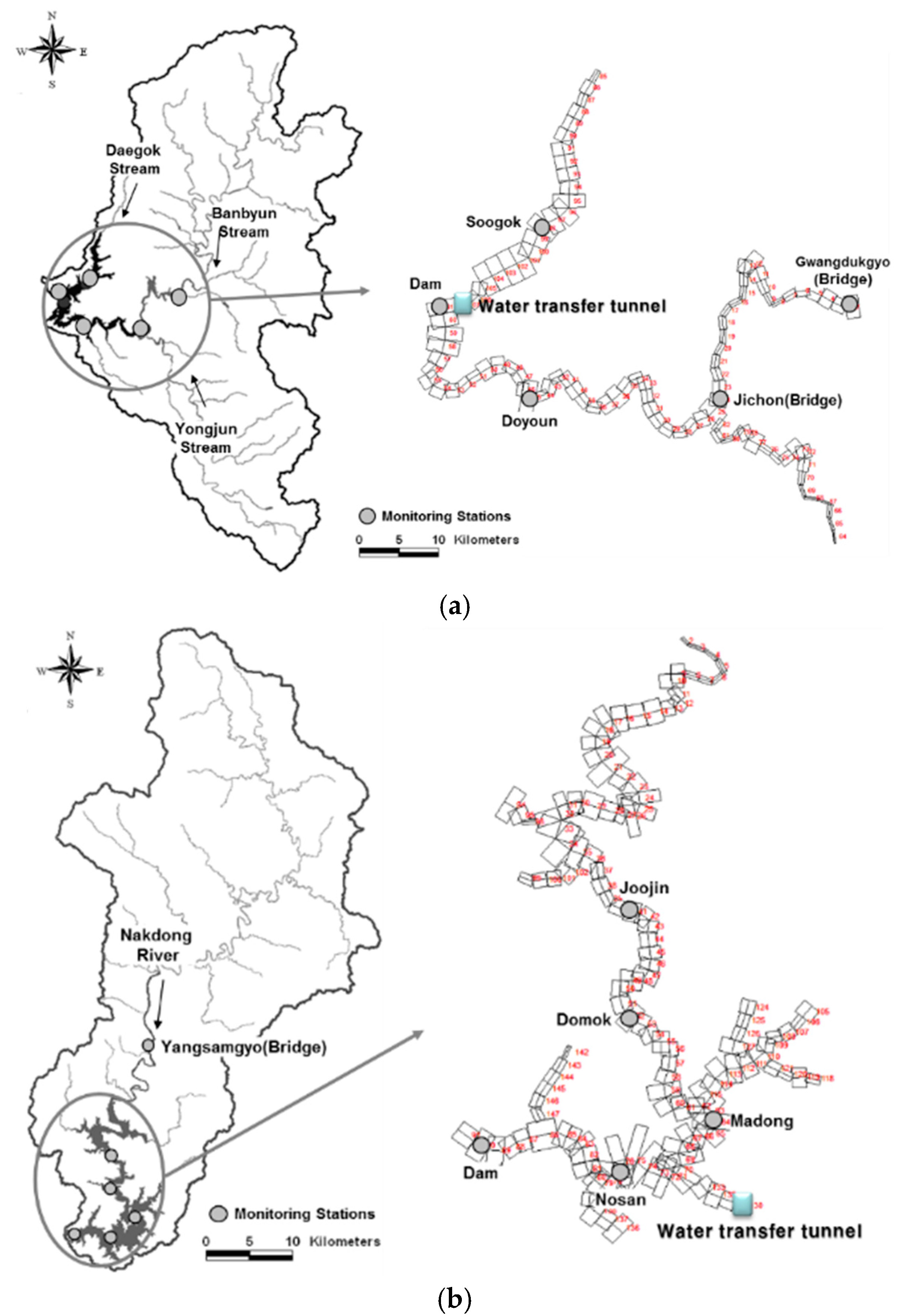
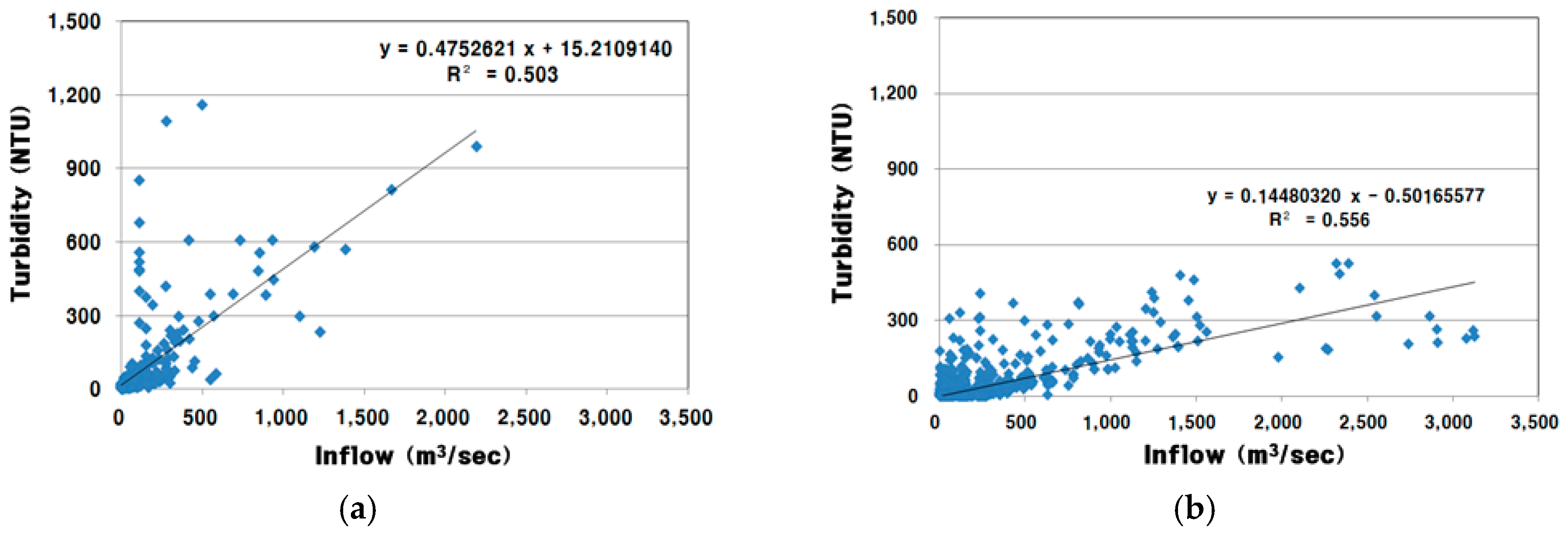


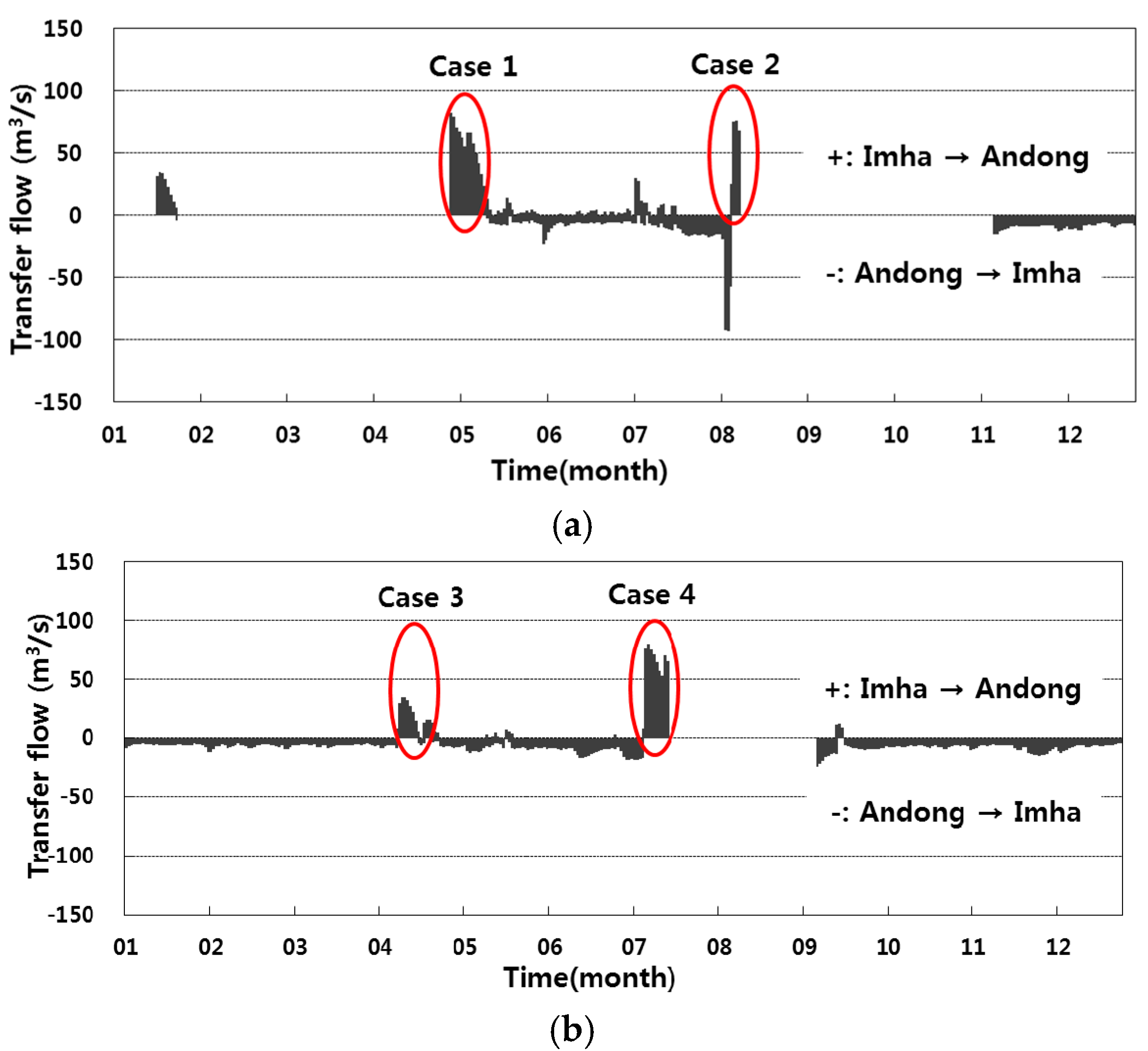
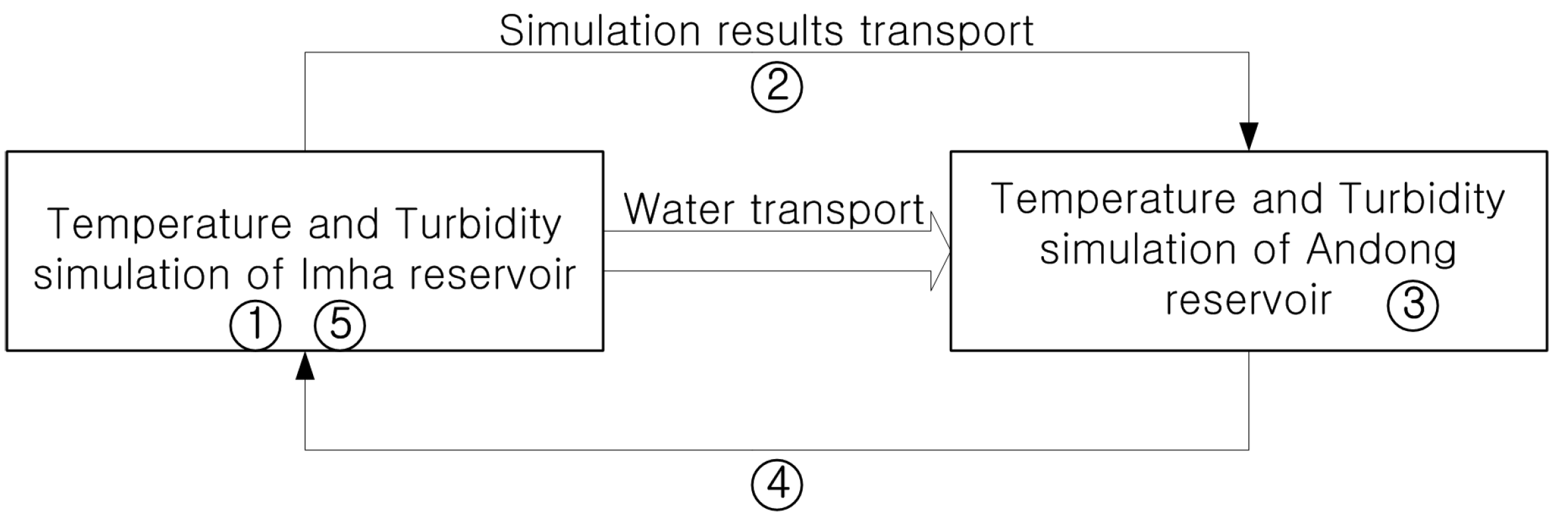
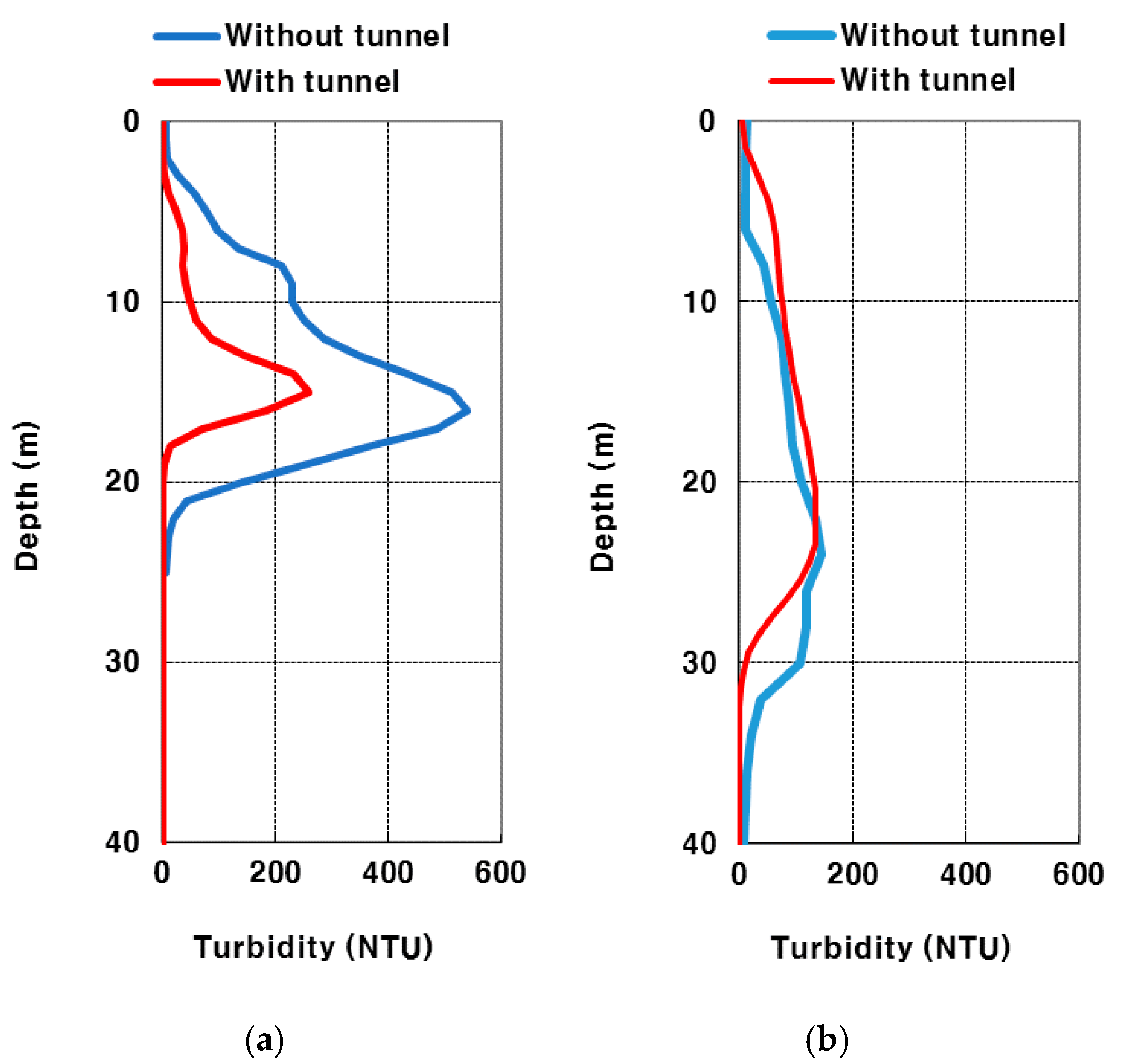
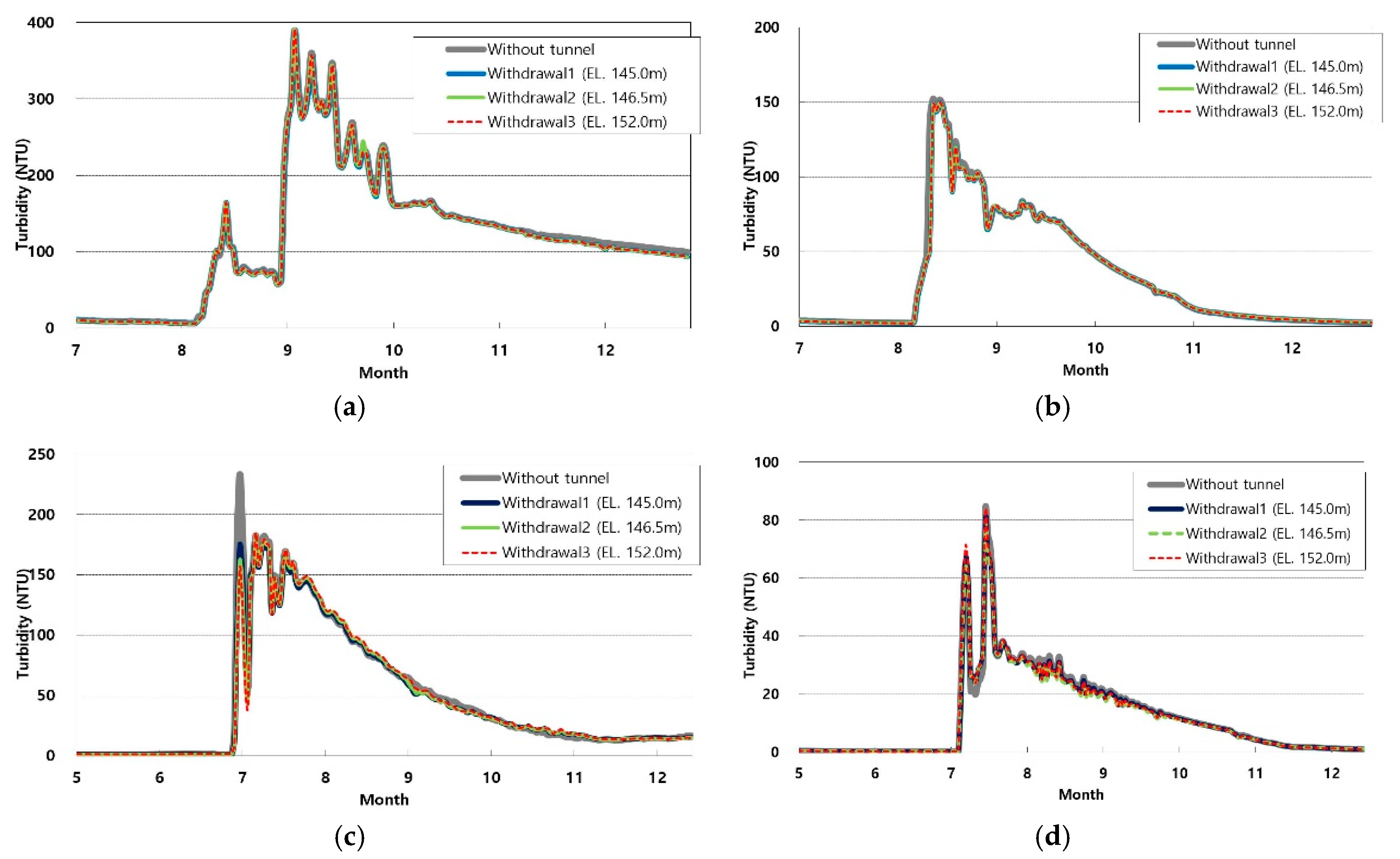
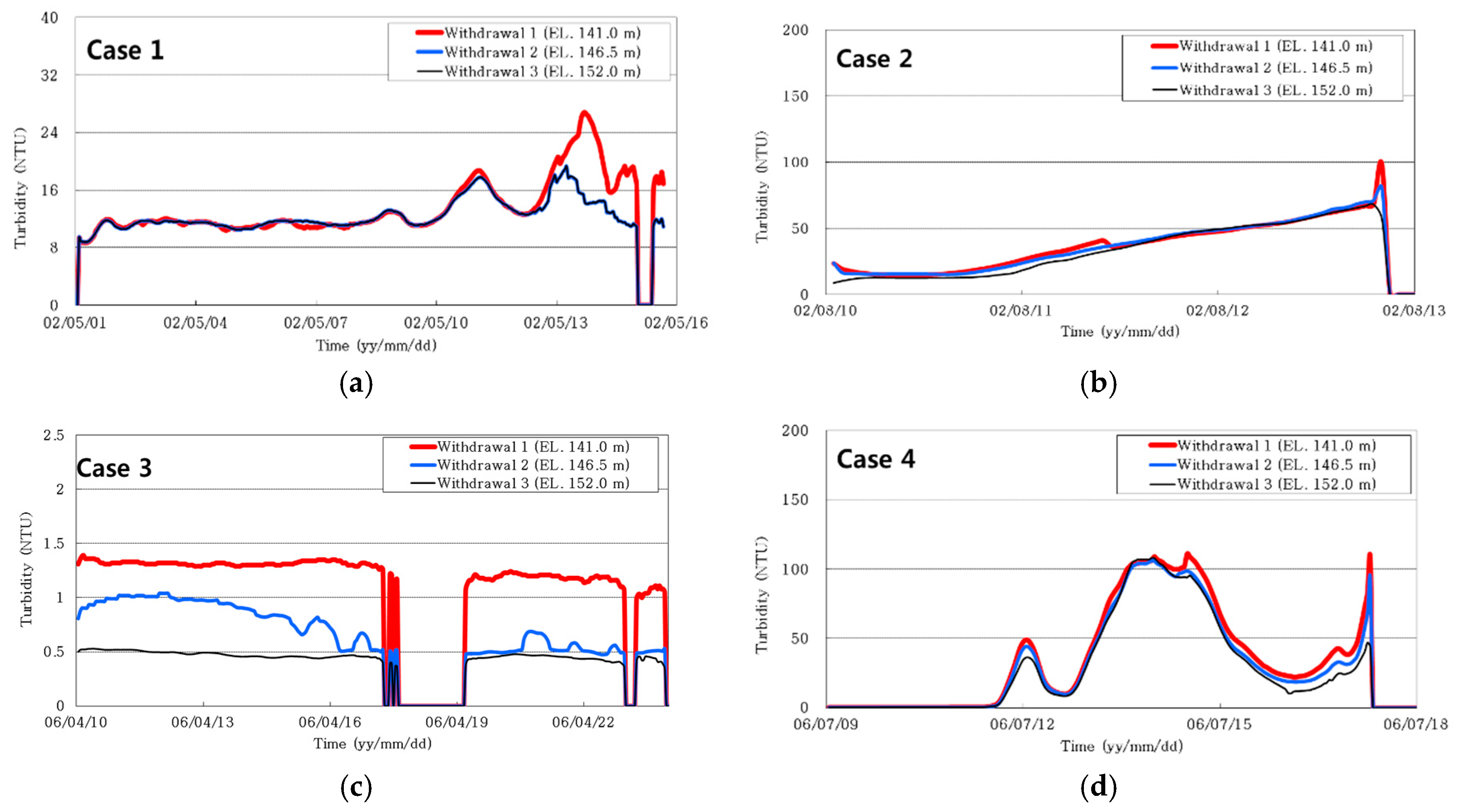
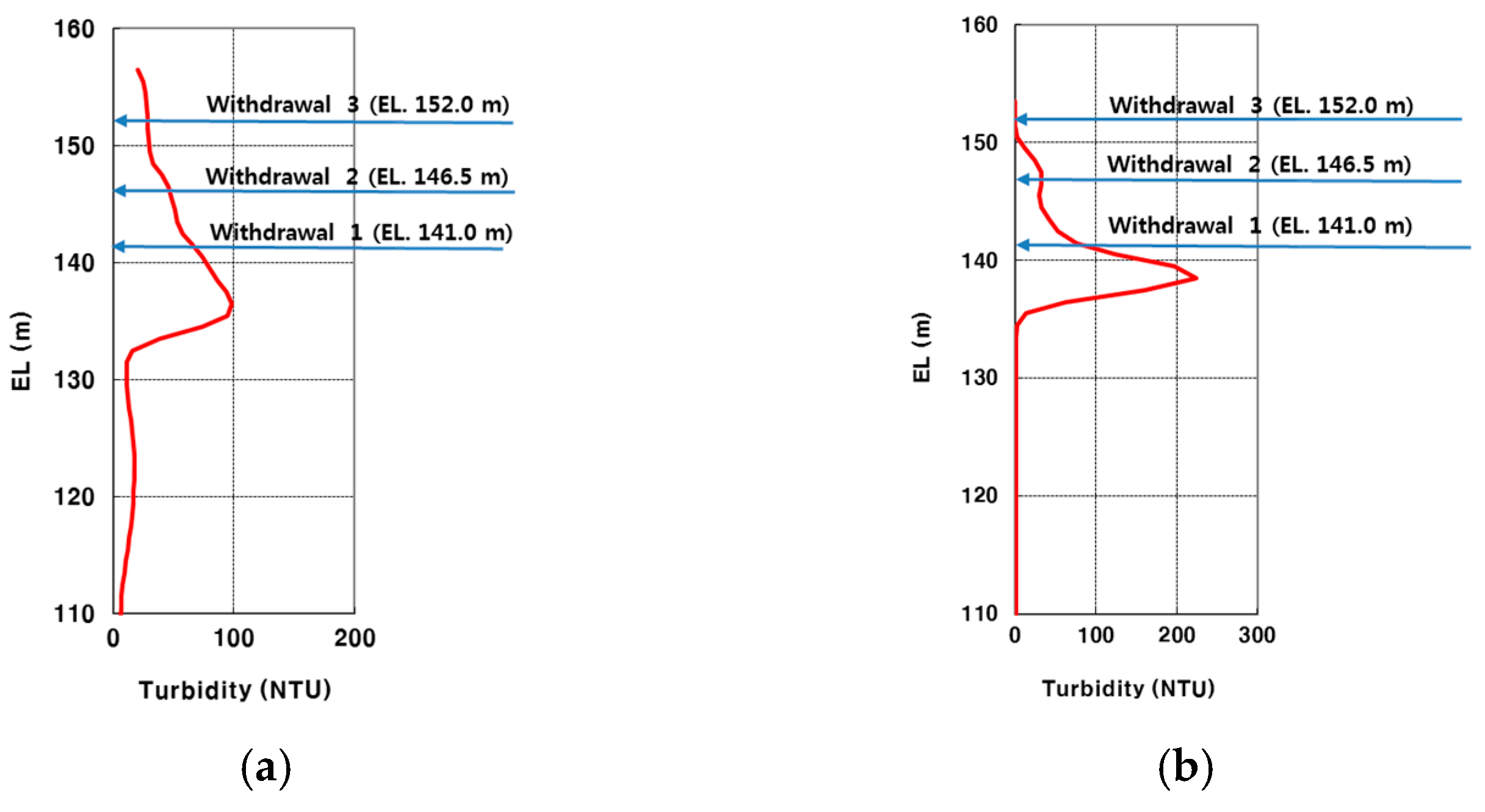
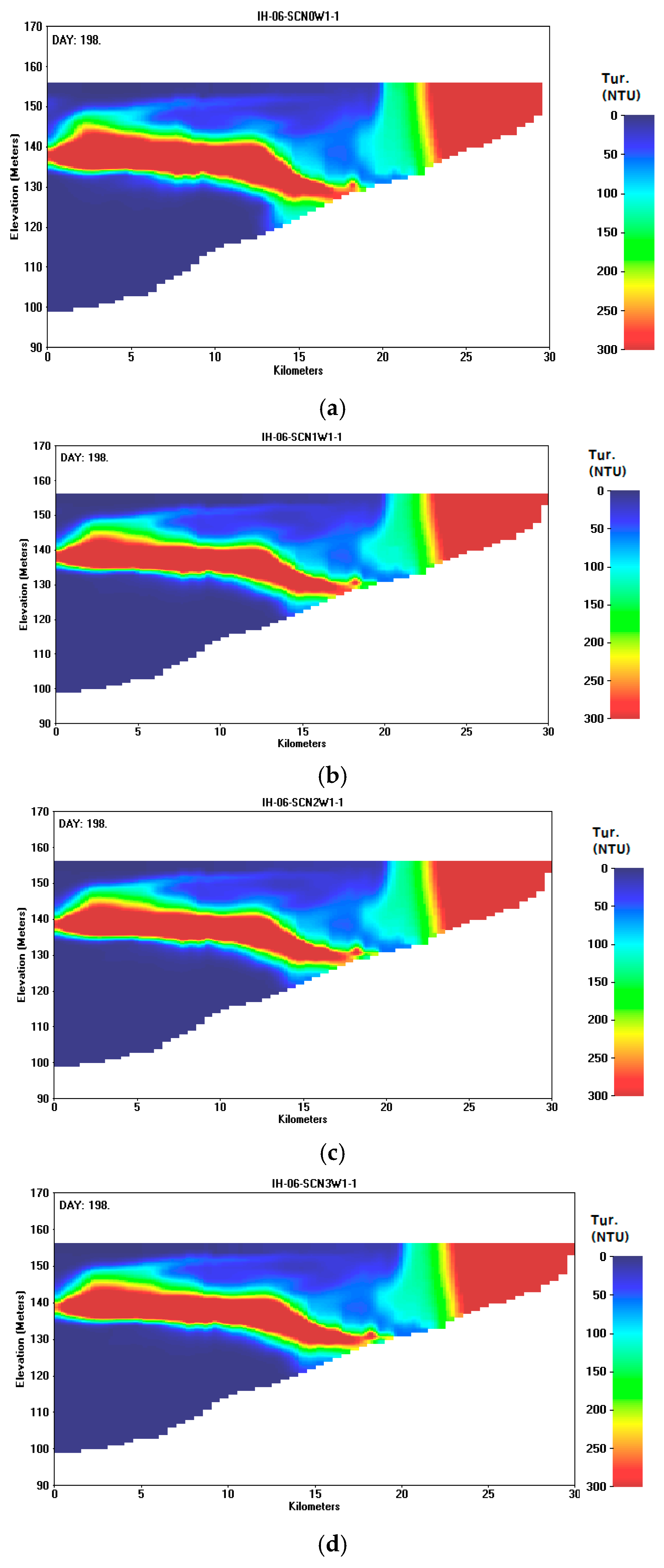
| Description | Andong Reservoir | Imha Reservoir |
|---|---|---|
| Dam crest elevation (EL. m) | 166 | 168 |
| Annual mean precipitation (mm) | 950.0 | 987.1 |
| Watershed area (km2) | 1584 | 1361 |
| Water surface area (km2) | 51.5 | 26.4 |
| Total storage volume (×106 m3) | 1248 | 595 |
| Normal water level (EL. m) | 160 | 163 |
| Dam height (m) | 83 | 73 |
| Dam length (m) | 612 | 515 |
| Parameters | Unit | Default (Cole and Buchak, 2003 [30]) | Imha Reservoir (Lee et al., 2007 [15]) | Daecheong Reservoir (Chung et al. 2007 [31]) | This Study |
|---|---|---|---|---|---|
| Horizontal eddy viscosity | m2/s | 1 | 1 | 1 | 1 |
| Horizontal eddy diffusivity | m2/s | 1 | 1 | 1 | 1 |
| Coefficient of bottom heat exchange | W/m2/s | 0.3 | - | 0.3 | 0.3 |
| Solar radiation absorbed in surface layer | - | 0.45 | 0.6 | 0.6 | 0.45 |
| Suspended Solids Settling rate | m/day | - | - | - | 0.05~0.1 |
| Carbonaceous biochemical oxygen demand (CBOD) decay rate | 1/day | - | - | - | 0.03 |
| Simulation Period (Year) | Description | |
|---|---|---|
| 2002 | Without a water transfer tunnel | |
| With a water transfer tunnel | Withdrawal 1 (EL. 141.0 m) | |
| Withdrawal 2 (EL. 146.5 m) | ||
| Withdrawal 3 (EL. 152.0 m) | ||
| 2006 | Without a water transfer tunnel | |
| With a water transfer tunnel | Withdrawal 1 (EL. 141.0 m) | |
| Withdrawal 2 (EL. 146.5 m) | ||
| Withdrawal 3 (EL. 152.0 m) | ||
© 2017 by the authors. Licensee MDPI, Basel, Switzerland. This article is an open access article distributed under the terms and conditions of the Creative Commons Attribution (CC BY) license (http://creativecommons.org/licenses/by/4.0/).
Share and Cite
Park, J.C.; Um, M.-J.; Song, Y.-I.; Hwang, H.-D.; Kim, M.M.; Park, D. Modeling of Turbidity Variation in Two Reservoirs Connected by a Water Transfer Tunnel in South Korea. Sustainability 2017, 9, 993. https://doi.org/10.3390/su9060993
Park JC, Um M-J, Song Y-I, Hwang H-D, Kim MM, Park D. Modeling of Turbidity Variation in Two Reservoirs Connected by a Water Transfer Tunnel in South Korea. Sustainability. 2017; 9(6):993. https://doi.org/10.3390/su9060993
Chicago/Turabian StylePark, Jae Chung, Myoung-Jin Um, Young-Il Song, Hyun-Dong Hwang, Mun Mo Kim, and Daeryong Park. 2017. "Modeling of Turbidity Variation in Two Reservoirs Connected by a Water Transfer Tunnel in South Korea" Sustainability 9, no. 6: 993. https://doi.org/10.3390/su9060993
APA StylePark, J. C., Um, M.-J., Song, Y.-I., Hwang, H.-D., Kim, M. M., & Park, D. (2017). Modeling of Turbidity Variation in Two Reservoirs Connected by a Water Transfer Tunnel in South Korea. Sustainability, 9(6), 993. https://doi.org/10.3390/su9060993








